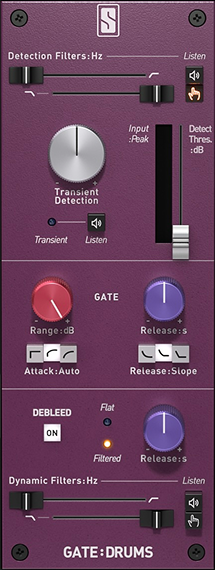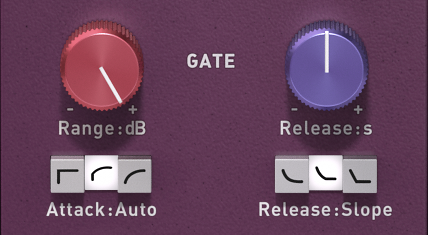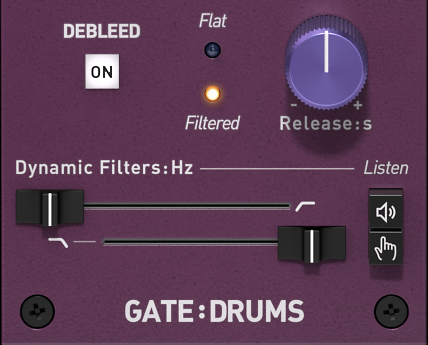Gate:Drums

Gate:Drums is a highly-sophisticated drum application. It combines a gate based on transient detection with smart dynamic filtering so you can achieve far cleaner drum tracks than with a conventional gate.
Unlike Gate:Classic, which is based on amplitude, Gate:Drums is based on transient input. This means that the gate is triggered by sharp and soft transients rather than volume levels.
With this unique processing, you can separate the transient from the signal tail, and apply different processes to each.
Transient: this is what we want to preserve, so the gate is open and dynamic filters are flat.
Tail: this is what we want to clean, so the gate is closed and dynamic filters are active. For example, it is possible to preserve a kick hit and reduce cymbal bleeds by using dynamic filters in high frequencies.
Following the workflow, the module is divided into three sections, from top to bottom:
Transient Detection: the first step of the workflow, i.e., adjusting the detection to catch only the desired transients.
Gate: the second step of the workflow, i.e., adjusting the floor and timing of the gate.
Debleed: the last step of the workflow, i.e., filter the tail when a transient is caught.
Transient Detection
Transient Detection
Transient Detection controls the ability of the gate to detect more or less transient.
With low values, only the sharp and strong hits are detected. With high values, softer and more complex transients like ghost notes can be detected.
Detection Threshold
Above this Threshold, Transients can be detected. Below, Transients cannot be detected. By excluding low levels, you can focus on a specific amplitude range and have a more precise Transient Detection.
Detection Filters
Filter the signal before the detection, so the gate only reacts to certain frequencies. A band pass behavior is possible by holding SHIFT when dragging one of the faders. This will automatically move the other fader accordingly.

Listen
 |
Solos the sidechain input |
 |
Option to auto-activate the sidechain listen as soon as you touch the filters |
Listen states are temporary, they are not saved in presets and not automatable.
External Side-Chain
When enabling the External Side-Chain, Gate:Drums will use an external source to open the gate. You will see the level of the external source on the vertical meter so you can set the Transient Detection Threshold appropriately. Adjusting the External Side-Chain Gain will also change the level in the detector, thus affecting the detection threshold.
Gate
Range
The Range sets the maximum amount of attenuation applied to the signal when the gate is closed.
Release
Release parameter defines the length of time the gate takes to change from open to fully closed. It is the fade-out duration.
Auto Attack
Engages an attack time only when necessary. Auto Attack detects signal inconsistencies that can cause clicks and pops and helps smooth them automatically with a timing that depends on the frequency of the signal.

 |
Off | No attack is applied |
 |
Tight | Different attack times are applied per band to preserve high frequencies |
 |
Smooth | Attack is applied on the overall signal, depending on low frequency amount |
Release Slope
The Release Slope defines the shape of the release envelope.
Debleed
Debleed On/Off
Enable the Dynamic Filters.
Release
Controls the speed of filter activation, once a transient has been detected.
Dynamic Filters
Once a transient has been detected, Dynamic Filters are Flat, and then they are progressively applied to the tail, depending on the Release and Range settings. Top fader is used to cut lows, whereas bottom fader is used to cut highs.
A band pass behavior is possible by holding SHIFT when dragging one of the faders. This will automatically move the other fader accordingly.

Listen
 |
Solos the sidechain input |
 |
Option to auto-activate the sidechain listen as soon as you touch the filters |
Listen states are temporary, they are not saved in presets and not automatable.
Signal Flow

Quickstep Guide
This example will be illustrated with a kick track: we want to remove bleed (snare, cymbals, toms) on a kick recording.
Transient Detection
-
Adjust the Transient Detection knob to catch the kick hits only.
-
If it is hard to find an optimal position (i.e. catching kick hits without catching other drum hits), try to use Detection Filters to focus on kick frequencies: detection will be more reactive on kick hits only.
-
If it is still hard to find an optimal position, try to use the Detection Threshold to focus on a specific amplitude range: detection will react on signal above this threshold only.
Gate
-
Adjust the Release depending on the kick tail you want to keep. A short release rapidly cuts the tail, whereas a long release lets the tail natural but lets pass other drum hits.
-
Adjust the Release Slope if you want a fade-out more or less abrupt.
-
Adjust the Auto Attack if audio clicks appear when a kick is detected.
-
The Range can be used at the end to soften the overall gate effect.
Debleed
-
Now that the kick is isolated, we may want to filter the tail to remove extra bleed cymbals for example.
-
Adjust Dynamic Filters, especially the LP to cut high frequencies and let the kick intact.
-
Adjust the Release to make the dynamic filtering more or less effective.